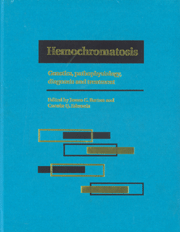Book contents
- Frontmatter
- Contents
- List of contributors
- Foreword
- Part I Introduction to hemochromatosis
- Part II Genetics of hemochromatosis
- Part III Metal absorption and metabolism in hemochromatosis
- Part IV Diagnostic techniques for iron overload
- 18 Liver biopsy in hemochromatosis
- 19 Histochemistry of iron and iron-associated proteins in hemochromatosis
- 20 Computed tomography and magnetic resonance imaging in the diagnosis of hemochromatosis
- Part V Complications of iron overload
- Part VI Therapy of hemochromatosis and iron overload
- Part VII Infections and immunity in hemochromatosis
- Part VIII Hemochromatosis heterozygotes
- Part IX Relationship of hemochromatosis to other disorders
- Part X Animal models of hemochromatosis and iron overload
- Part XI Screening for hemochromatosis
- Part XII Hemochromatosis: societal and ethical issues
- Part XIII Final issues
- Index
20 - Computed tomography and magnetic resonance imaging in the diagnosis of hemochromatosis
from Part IV - Diagnostic techniques for iron overload
Published online by Cambridge University Press: 05 August 2011
- Frontmatter
- Contents
- List of contributors
- Foreword
- Part I Introduction to hemochromatosis
- Part II Genetics of hemochromatosis
- Part III Metal absorption and metabolism in hemochromatosis
- Part IV Diagnostic techniques for iron overload
- 18 Liver biopsy in hemochromatosis
- 19 Histochemistry of iron and iron-associated proteins in hemochromatosis
- 20 Computed tomography and magnetic resonance imaging in the diagnosis of hemochromatosis
- Part V Complications of iron overload
- Part VI Therapy of hemochromatosis and iron overload
- Part VII Infections and immunity in hemochromatosis
- Part VIII Hemochromatosis heterozygotes
- Part IX Relationship of hemochromatosis to other disorders
- Part X Animal models of hemochromatosis and iron overload
- Part XI Screening for hemochromatosis
- Part XII Hemochromatosis: societal and ethical issues
- Part XIII Final issues
- Index
Summary
Introduction
The diagnosis of hemochromatosis can be made in different circumstances: (i) in symptomatic individuals who present with clinical features suggestive of the disorder; (ii) in persons who are discovered to have abnormal serum iron tests; or (iii) in persons who are evaluated in the context of a family study. The insufficient sensitivity and specificity of serum iron tests (transferrin saturation and serum ferritin concentration) sometimes do not permit a definite diagnosis to be made until a hepatic biopsy has been performed. Histologic examination of the liver is an important element in the diagnosis of hemochromatosis, because: (i) it reveals hepatic iron overload and permits an assessment to be made of the distribution of iron in the liver (typically, iron deposition occurs in hepatocytes with periportal and perilobular distribution); (ii) it permits biochemical measurement of hepatic iron concentration to be performed. A hepatic iron index (hepatic iron concentration/ age ratio)> .1.9 is helpful in establishing a diagnosis of hemochromatosis homozygosity; and (iii) it provides assessment of the degree of fibrosis which is of major prognostic significance.
Due to the physical properties of iron, iron overload is responsible for modifications in computed tomography attenuation and magnetic resonance signal intensity of the liver. This has promoted interest in developing these principles as a quantitative method to assess hepatic iron concentration. In this chapter, the focus is on the radiologic, non-invasive diagnosis of iron overload and on providing additional information about radiologic features of hepatocellular carcinoma arising in patients with hemochromatosis.
- Type
- Chapter
- Information
- HemochromatosisGenetics, Pathophysiology, Diagnosis and Treatment, pp. 219 - 226Publisher: Cambridge University PressPrint publication year: 2000
- 1
- Cited by



